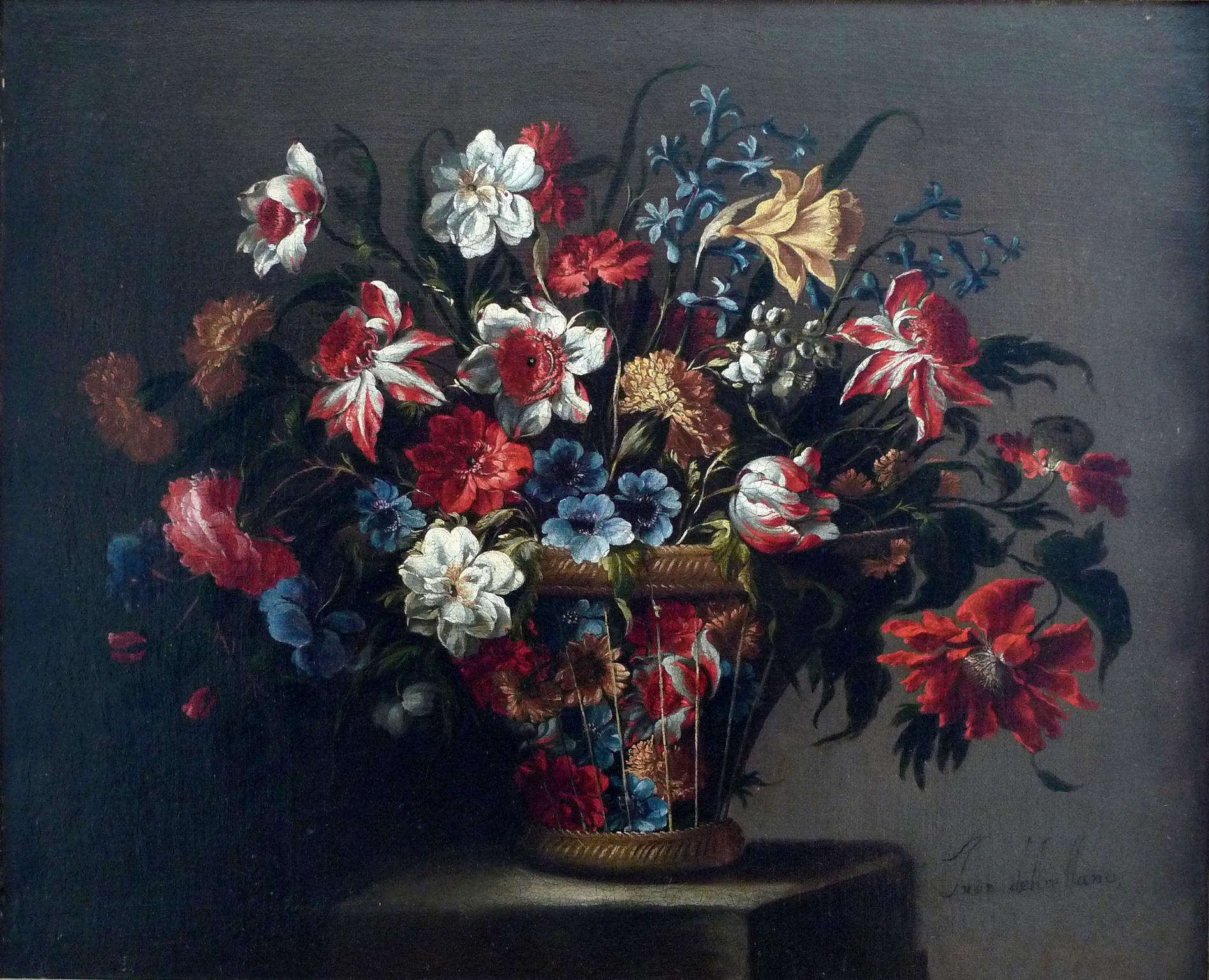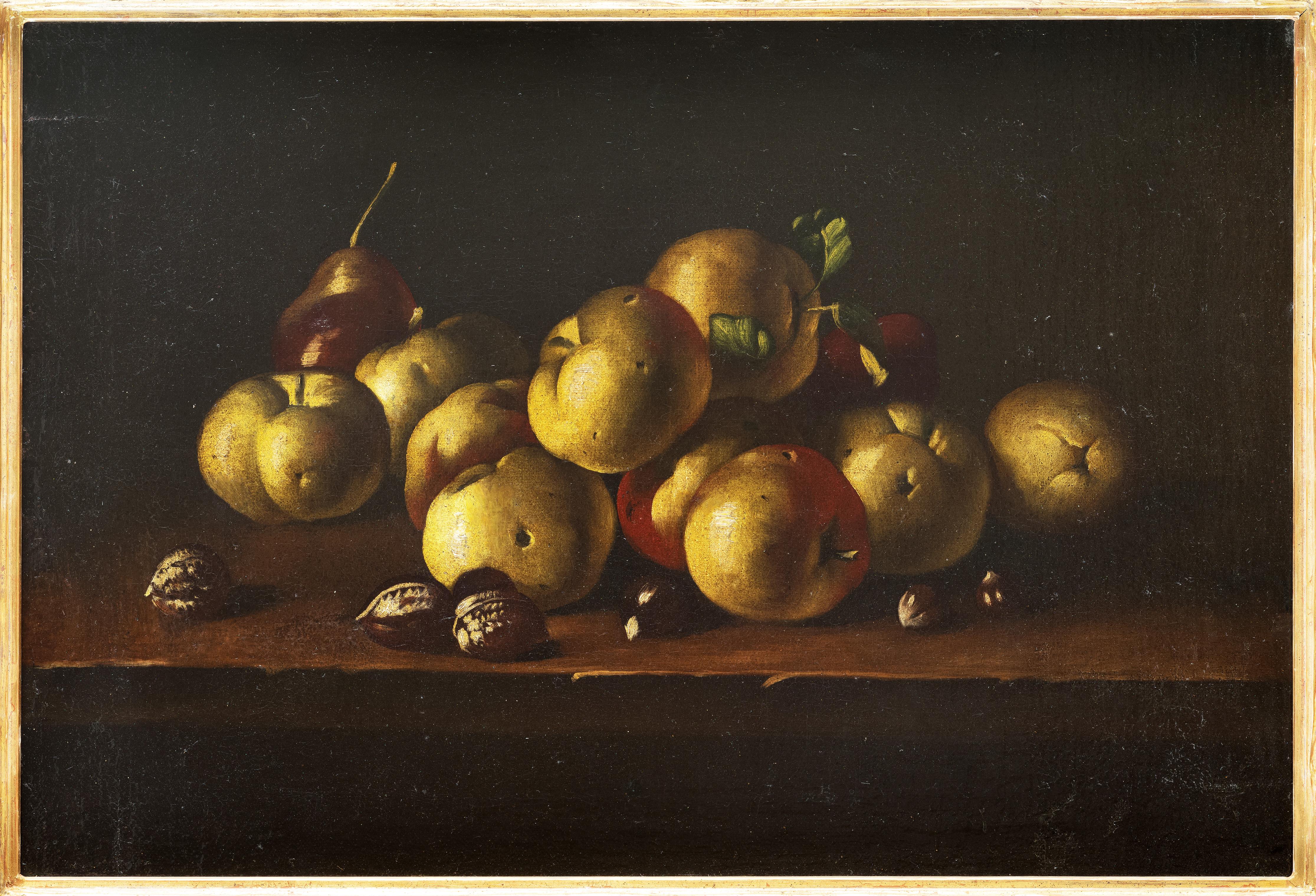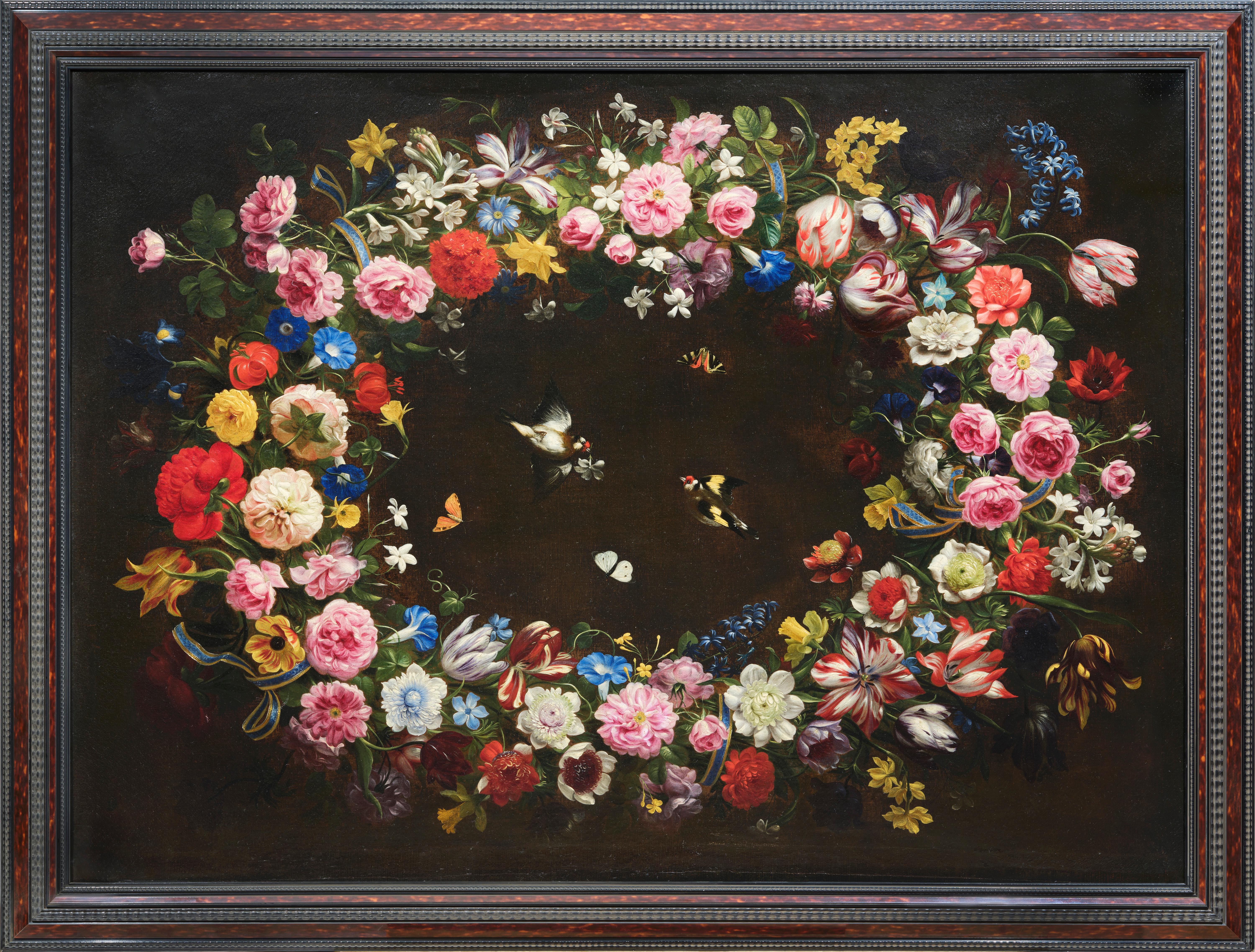Items Similar to Still-Life Flower Landscape Castelli Paint Oil on canvas Old master Italian art
Video Loading
Want more images or videos?
Request additional images or videos from the seller
1 of 19
Still-Life Flower Landscape Castelli Paint Oil on canvas Old master Italian art1690-1740
1690-1740
About the Item
Still life in a landscape with fruit and game
Work of the late Roman Baroque of the late seventeenth / eaarly eighteenth century
attributable to Giovanni Paolo Castelli, known as Spadino (Rome, 1659 - 1730)
oil on canvas
62 x 76 cm., Framed 90 x 109 cm.
An open-air setting, with a hilly landscape gash that opens into the distance in the central part, surrounds our beautiful canvas, which showcases a rich selection of game and fruit, arranged in the foreground near the point of view of the observer, occupying a large part of the visual field with their bright and festive colors.
The style and quality of the work, like the pictorial technique of this still life, characterized by subtle luminous vibrations and a lively chroma, make it attributable to the Roman Giovanni Paolo Castelli, known as Lo Spadino (Rome, 1659 - 1730), one of the most important specialists of this pictorial genre of late Baroque Rome, which had a very successful career between the 17th and 18th centuries.
Analyzing the rich and heterogeneous catalog of the Roman master, in fact, our canvas can be included among his rare works which, alongside a selection of fruit - among which stand out large melons, ripe figs, dark grapes and plums - we see a game advert, presumably as requested by a patron who loves hunting. Next to various birds, spoils of a profitable hunting trip, there is also a small green woodpecker, with the characteristic red spot on the head, and a nice rodent that terminates from behind the trunk.
The painter abandons himself to a skilful and brilliant chromatic texture of the surfaces, through a pictorial material rendered with exceptional vibration in its luminous and 'tactile' body, fully respecting the taste of the full Roman Baroque.
The quality appears excellent, distinguished by a skilful and brilliant chromatic texture of the surfaces, which appear almost vibrant thanks to a skilful drafting of the pictorial material.
Inevitable and evident are the Flemish suggestions, which had influenced the Roman Baroque still life, in particular the work of Abraham Brueghel.
Giovanni Paolo Castelli could boast a family workshop (in which his brother and son worked) long appreciated in the Rome of the second half of the seventeenth century, specialized in the genre of still life, which allowed him to quickly achieve considerable fame, working for the most important Roman families, such as the Chigi, Cardinal Pamphili who owned eleven Spadino, the Spada and the Rospigliosi.
By way of comparison, among the works similar to ours, similar in scenic and stylistic organization, we can mention:
- Still life with melon, peaches, grapes, game, guinea pig and hens, Sotheby's, New York, January 17, 1992, and now Private collection,
- Still life with pomegranates, peaches, plums and birds (Private collection, Gardone
- Still life with fruit and parrot, "Domenico Inzaghi" Civic Art Gallery, Budrio
- Still life with fruit, mushrooms and bird, Antiques market, Verona
- Still life with watermelon, peaches, grapes and pomegranate, "Fortunato Duranti" Civic Art Gallery, Montefortino
- Still life with melon, watermelon, peaches, grapes, figs and pomegranate, Private Collection
- Still life with fruit, jug and bird, Palazzo Blu, Fondazione CariPisa collection, Pisa
The painting is completed by a pleasant antique frame that suits it well and is sold with a certificate of authenticity in accordance with the law.
- Attributed to:Giovanni Paolo Castelli, known as Spadino (Rome, 1659 - 1730) (1659 - 1730, Italian)
- Creation Year:1690-1740
- Dimensions:Height: 35.44 in (90 cm)Width: 42.92 in (109 cm)
- Medium:
- Movement & Style:
- Period:Late 17th Century
- Condition:
- Gallery Location:Riva del Garda, IT
- Reference Number:1stDibs: LU98818680702
About the Seller
4.8
Platinum Seller
These expertly vetted sellers are 1stDibs' most experienced sellers and are rated highest by our customers.
Established in 2017
1stDibs seller since 2018
207 sales on 1stDibs
Typical response time: <1 hour
- ShippingRetrieving quote...Ships From: Riva del Garda, Italy
- Return PolicyA return for this item may be initiated within 7 days of delivery.
More From This SellerView All
- De Wit Flowers Still life Paint Oil on canvas 18th Century Flemish Cupids ArtLocated in Riva del Garda, ITJacob De Wit (Amsterdam, 1695 - 1754) attributable/ workshop Pair of Cupids with Garland of Flowers Oil on canvas 91 x 103 cm. - Framed 104 x 115 cm. Provenance: Christie's (London, Old master Painting 12.12.1996) lot 82 This magnificent composition depicts two cupids holding a garland of flowers, placed on a fine architecture with bas-reliefs and masks, presumably the top of a fountain. One of the two cupids sympathetically holds a part of it with his hands, while his head turns towards the viewer; the second cupid, on the other hand, must have clumsily broken the thread holding its end, and is sitting sullenly with a torch and a tear streaking his chubby cheek. The work, given its stylistic features and compositional taste, can be attributed to the Flemish artist Jacob de Wit (Amsterdam, 1695 - 1754), or to an artist from his workshop, with his typical triumphal and opulent style, which reveals clear influences from Rubens and Van Dijck, but also from Gerard de Lairesse...Category
18th Century Old Masters Paintings
MaterialsOil
- Still Lifes Flowers De Arellano Paint 17th Century Oil on canvas Old master ArtLocated in Riva del Garda, ITJosè de Arellano (Madrid, 1653 - c. 1714) attributable Pair of still lifes of flowers Oil on canvas 37 x 45 cm. - In period frames 50 x 59 cm. Pair of still lifes, each depicting a...Category
17th Century Old Masters Paintings
MaterialsOil
- Flower Garland Virgin Paint Oil on canvas Old master 17th Century ItalyBy Giovanni StanchiLocated in Riva del Garda, ITGiovanni Stanchi (Rome 1608 - 1675) or Niccolò Stanchi (Rome 1623 - 1690), workshop of GARLAND OF FLOWERS WITH PORTRAIT OF THE VIRGIN Rome, First half of the Seventeenth century o...Category
17th Century Old Masters Paintings
MaterialsOil
- Still Life Crystal Goblet Van Ravesteyn Paint 17/18th Century Oil on canvas ArtLocated in Riva del Garda, ITStill life with a crystal goblet and a painted ceramic jug Hubert van Ravesteyn (Dordrecht 1638-1683) workshop/cerchia Flemish painter, mid 17th century Oil on canvas 59 x 74 cm. - Framed 74 x 88 cm. Provenance: Hampel Munich, 29.06.2023, lot 1017 € 8.000-12.000 The composition offers us a typical Flemish still life of the 17th century where, carefully arranged starting from the left edge of the table partially covered by a cloth, we can admire, in order, a magnificent Venetian crystal goblet...Category
17th Century Old Masters Paintings
MaterialsOil
- Flower Still-life Virgin Trevisani Stanchi Paint Oil on canvas 17/18th CenturyBy Francesco Trevisani (Capodistria 1656 - Rome 1746)Located in Riva del Garda, ITFlower garland with a portrait of the Virgin Francesco Trevisani (Capodistria 1656 - Rome 1746) and Niccolò Stanchi (Rome 1623 - 1690), attributable Oil on canvas 66 x 49 cm. - In f...Category
18th Century Old Masters Still-life Paintings
MaterialsOil
- Pieter Casteels III 'Signed' Floral Still Life Old master Paint 18th Century ArtBy Pieter Casteels III (Antwerp 1684 - 1749 Richmond)Located in Riva del Garda, ITPieter Casteels III (Antwerp 1684 - 1749 Richmond) circle Floral still life Signed lower left, on the stone: P Casteels About 1730 Oil painting on...Category
18th Century Old Masters Paintings
MaterialsOil
You May Also Like
- Still Life with Fishes and Oysters - Oil on Canvas - 17th CenturyLocated in Roma, ITStill life with fishes and oysters is an original oil on canvas realized in the 17th Century by Neapolitan School Master. Impressive in size as well as for its vivid representation o...Category
17th Century Old Masters Still-life Paintings
MaterialsOil
- "Cesta de flores", 17th Century Oil on Canvas, Still Flowers by Juan de ArellanoBy Juan de ArellanoLocated in Madrid, ESJUAN DE ARELLANO Spanish, 1614 - 1676 Cesta de Flores signed Juan de Arellano (lower lright) oil on canvas original period carved, gilt and polychrome...Category
17th Century Old Masters Still-life Paintings
MaterialsCanvas, Oil
- A gentleman’s vicesLocated in London, GBEnglish School, circa 1827 A gentleman’s vices the newspaper dated ‘Sunday December 23 1827’ (upper left) oil on canvas 20 ¾ x 24 ½ in. (52.7 x 62.3 cm.) frame 25 ⅝ x 29 ¼ in. (65.1...Category
Early 19th Century Old Masters Still-life Paintings
MaterialsCanvas, Oil
- Still Life with Apples and Nuts, 17th Century, Old Master, Spanish PaintingLocated in Greven, DEJuan Sánchez Cotán (1560 - 1627) was one of the most important still life painters in Spain and beyond. He developed a certain type of still life with a ...Category
17th Century Old Masters Still-life Paintings
MaterialsCanvas, Oil
- Flower Garland by Giovanni Stanchi, the most Flemish Italian flower painterBy Giovanni StanchiLocated in PARIS, FRThis painting is reproduced in the reference book on Roman still life "Pittori di nature morta a Roma - artisti italiani 1630 -1750" by Gianluca and Ulisse Bocchi - Arti Grafiche Castello 2005 (page 250 figure FS5), where it is mentioned as one of the few paintings that can be given with certainty to Giovanni Stanchi. This highly decorative flower garland reveals a very strong Flemish influence, enabling us to attribute it with certainty to Giovanni Stanchi, the eldest of a sibling group of painters active in the production of still lifes in 17th century Rome. Probably painted before 1640, our garland conceals a mystical message beneath its decorative opulence, which we're about to reveal ... 1. Giovanni, Niccolò and Angelo Stanchi, a brotherhood of still-life painters in 17th-century Baroque Rome The three Stanchi brothers, Giovanni (1608 - after 1675), Niccolò (ca. 1623 - 1690) and Angelo (1626 - after 1675) lived and worked together (like the Le Nain brothers), making identification of the different hands perilous. Giovanni Stanchi's name is first mentioned in 1634, in the register of the painters' guild of the "Accademia di San Luca". Paid membership of the painters' guild provided not only a social network, but also commissions from important Roman families. In 1638, Giovanni Stanchi painted a picture for the Barberini family depicting their coat of arms surrounded by flowers. In 1660, he was commissioned by Cardinal Flavio Chigi to decorate a gallery with still lifes of flowers and fruit. The Chigis remained his principal patrons until after 1673. Thereafter, he received commissions from almost every important family in Rome. An invoice dated 1670 identifies Giovanni Stanchi and Mario Nuzzi as the painters responsible for the still lifes that decorated the famous mirrors in Palazzo Colonna. In 1675, Giovanni Stanchi's name appears for the last time in connection with a project in which he was engaged, together with Andries Bosman and the figure painter Ciro Ferri, to decorate the mirrors of the Palazzo Borghese on Campo Marzio. Although all three brothers were active as painters, the records of their commissions always refer to Giovanni, since, as eldest brother, he was responsible for invoices and contracts. Only in a few cases is the name of one of the younger brothers mentioned. Only paintings with a strong Flemish influence dating from the first four decades of the 17th century, such as this one, can be attributed with certainty to Giovanni, as he was the only painter in the family at the time. 2. History of a genre: the flower garland Jan Brueghel the Elder (Brussels 1568 - Antwerp 1625) is credited with inventing the flower garland theme during his stay in Rome in 1592. Such garlands were originally used to surround a religious subject, often a Marian one. This religious scene could sometimes be painted by another artist, as in the painting acquired in 1608 by Cardinal Borromeo, featuring a Madonna (painted by Henry van Balen), surrounded by a garland painted by Jan Brueghel. This theme was taken up and developed in Rome from 1625 onwards by Daniel Seghers, before the young Giovanni Stanchi made it his own, reinforcing its symbolic dimension (to which we shall return) and moving away from the naturalistic approach of Jan Brueghel to develop a certain idealization of each flower, closer to the style of Mario Nuzzi (Rome 1603 - 1673). Giovanni Stanchi's garlands, of which he was the best Italian interpreter in the 17th century, also reveal him to be one of the most faithful to the Flemish tradition. The book by Gianluca and Ulisse Bocchi lists nine still lifes very similar to ours, all executed on a black background (including the one reproduced as the last photo in the gallery, which belongs to the Pinacoteca Nazionale in Bologna). Because of their proximity to Flemish works, they can be attributed with certainty to Giovanni Stanchi. Four of them belong to private collections, while the others are all in public institutions (Anhaltische Gemäldegalerie, Dessau; Galeria del Palazzo Bianco, Genoa; Musée des Beaux-Arts, Bordeaux; Pinacoteca Nazionale, Bologna; Palazzo Chigi-Saraceni, Siena). Like those in Flemish still lifes, the flowers depicted by Giovanni Stanchi bloom at different times of the year, ruling out any representation of a real bouquet. Alongside the more traditional flowers of our gardens (roses, tulips, hyacinths, daffodils, irises), it is also interesting to note the frequent inclusion of more exotic flowers such as jasmine and blue bindweed (ipomoea indica), which had been recently introduced to Europe from Mexico. Each flower painted by Giovanni Stanchi seems to have its own individuality, a trait characteristic of Flemish painting, of which Stanchi was the best interpreter in Italy. One could say that Stanchi does not depict garlands of flowers, but flowers in a garland, each with its own identity and specificity, making it unique and different from the others. Captured in a low-angled light that seems to have captured them for eternity, they are drawn with clear, precise lines. As if they had been freshly cut, they emerge from the darkness in geometric figures that reinforce the tactile quality of their representation. One of Giovanni Stanchi's distinctive features is to have substituted the central religious representation traditionally associated with Flemish flower...Category
17th Century Old Masters Still-life Paintings
MaterialsCanvas, Oil
- Pair of Large Floral Still Lifes in the Old Master StyleLocated in London, GBPair of large floral still lifes in the Old Master style Continental, Early 20th Century Canvas: Height 120cm, width 90cm Frame: Height 141cm, width 111cm, depth 6cm This pair of b...Category
Early 20th Century Old Masters Still-life Paintings
MaterialsOil, Wood, Canvas
Recently Viewed
View AllMore Ways To Browse
Art As Antique
Antique Italian Art
Antique Flower Art
Antique Art Materials
Large Old Master
Old Masters Italy
Italian Baroque Art
Antique Italian Framed Art
Italian Dark Art
Small Painted Flowers
Small Old Paintings
Antique Still Life Flowers
Large Oil Painting Masters
Old Green Paint
Oil On Canvas Old Masters
Large Old Master Italian
Old Flower Painting
Old Painting Of Flowers




